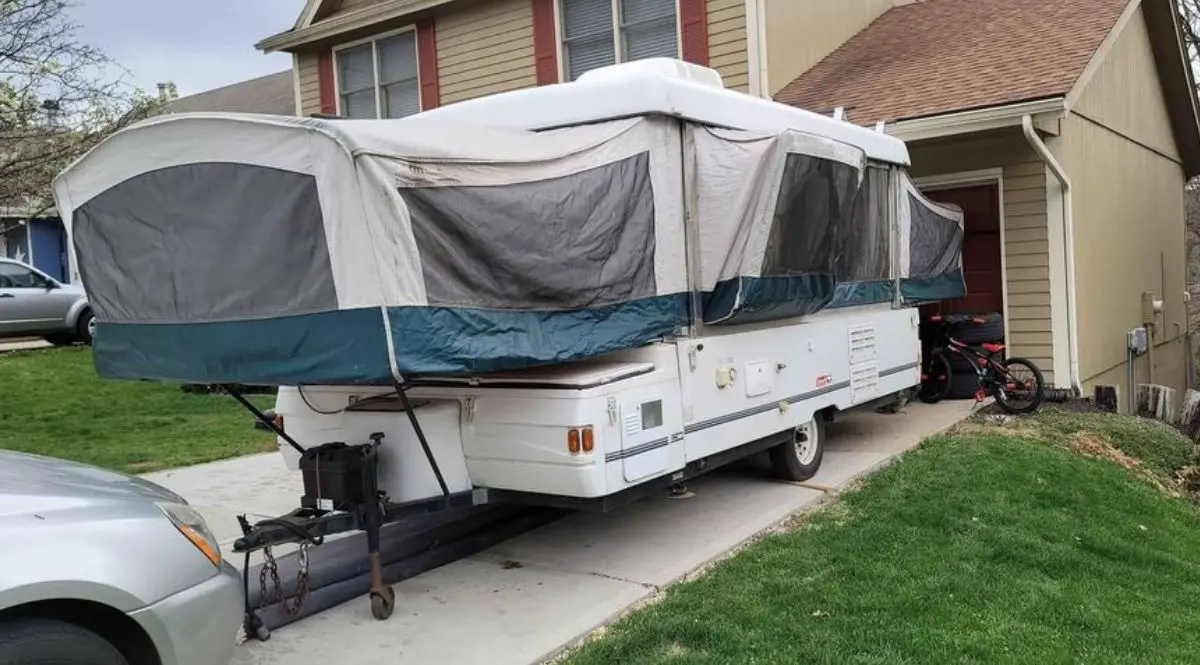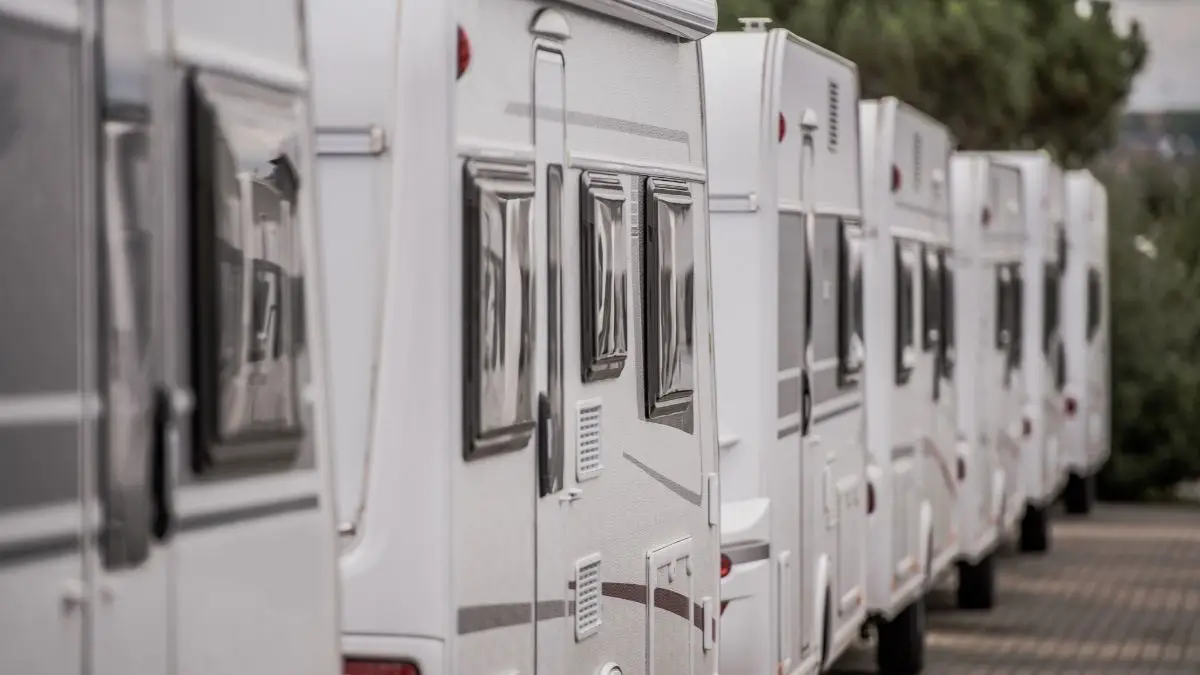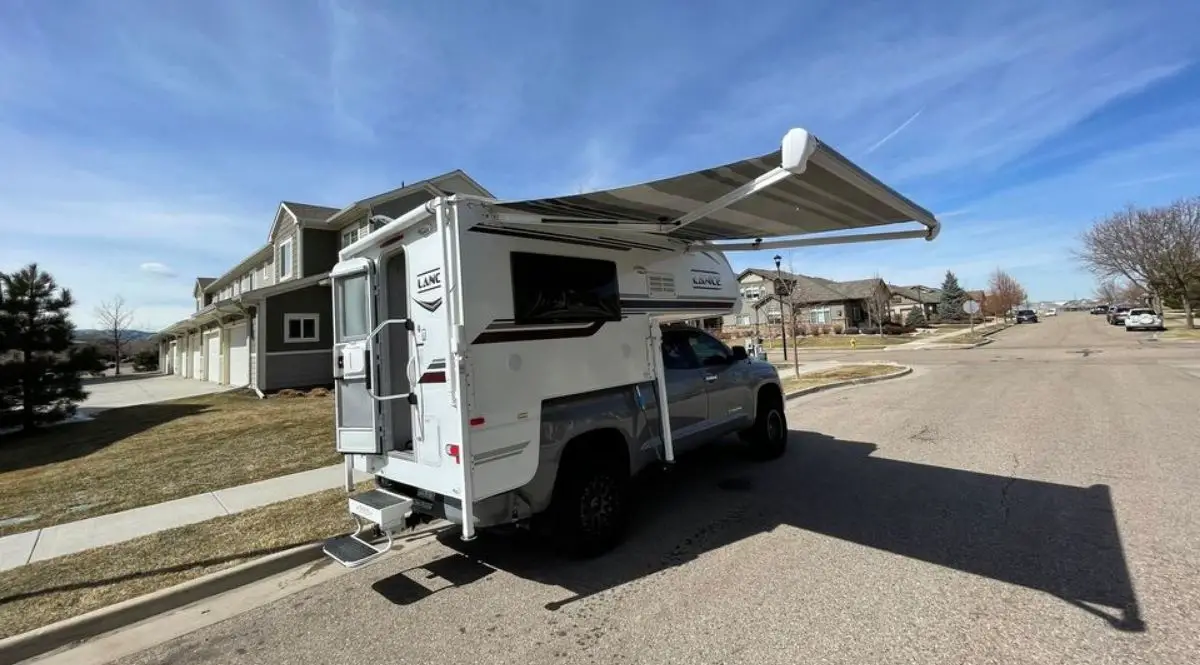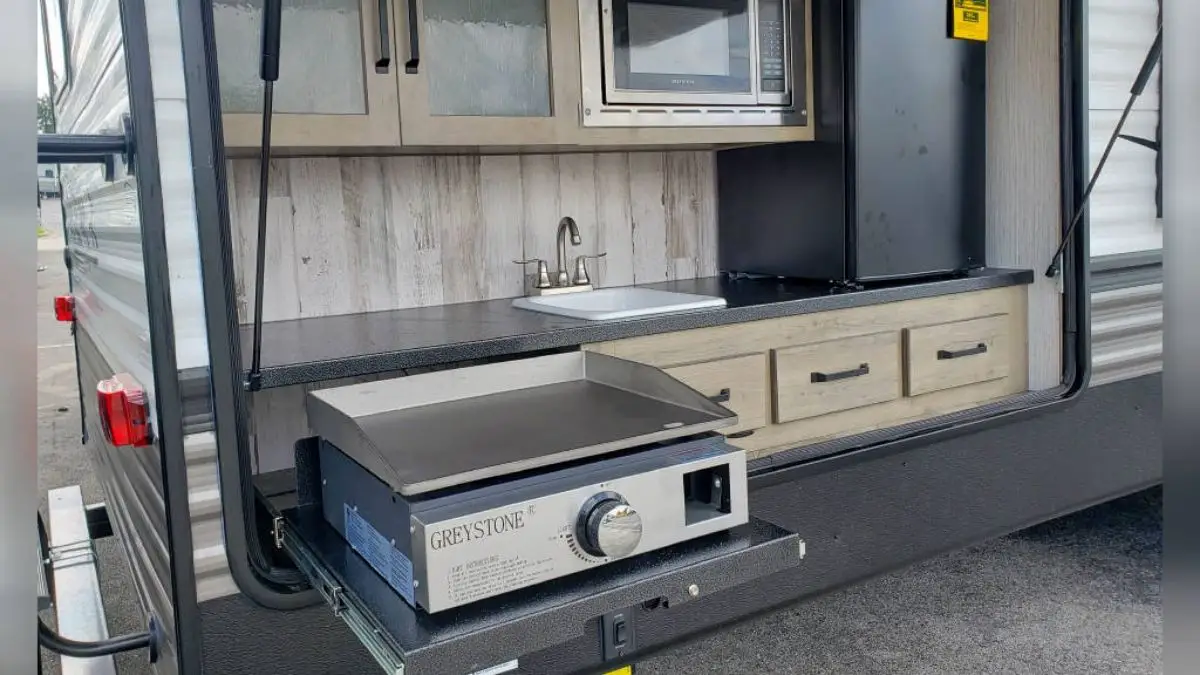If you are new to RVing or perhaps considering stepping up from tent camping, then a pop-up camper may provide the sort of cost-effective, home on wheels that you’re looking for.
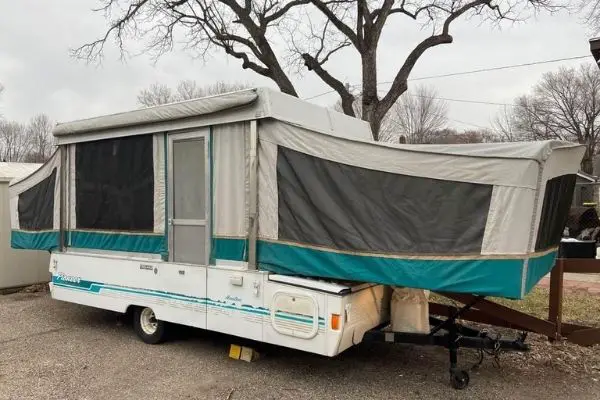
My wife and I rented a pop-up camper before we got our motorhome, and it was an experience. Like any purchase, there are many things to consider. And as with all styles of camping, there are advantages and disadvantages to pop-up campers.
Here’s what I have come up with should you consider before buying a pop-up camper. I’ll cover the good and bad points of pop-up camping and you can gain my experience and research without having to do it yourself.
Staying In A Pop-Up Camper Is Like Staying In A Tent
Pop-up campers may feel like an upgrade on tent camping, but they share many of the same issues. A pop-up camper’s advantages over a standard trailer are its lightweight and ability to fold down. But these advantages come through the use of canvas and fabric.
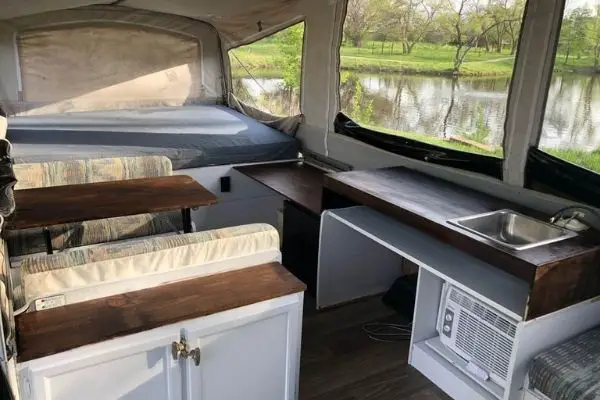
If you are looking for increased privacy and a reduction in the campground noise you’ve experienced as a tent camper, a pop-up camper is unlikely to give you a major upgrade. You will gain indoor seating, a kitchen table, (probably) a kitchen sink, and beds with full mattresses so it is a matter of evaluating and balancing.
Pop Up Campers Get Hot …. They Also Get Cold
Like tents, the temperature inside a pop-up camper reflects the weather outside. The canvas slideouts mean little difference between temperatures inside and out, unfortunately. On hot summer days, pop-ups can get extremely hot. A few top-end pop-up campers have air conditioning units, but you’ll need at least a 30Amp connection to make use of this.
Similarly, on colder days, pop-up campers can be refrigerated cold or worse. Adding heaters is an option but relies on an electrical hook-up or a generator. Invest in winter-grade sleeping bags and possibly a mattress heating pad in order to enjoy the winter months. There are even some pop-ups with winterized packages if this is a key concern.
Pop Up Campers Do Not Usually Have Bathrooms
If one goal of purchasing a pop-up camper is to finally have a private bathroom for you and your traveling companions, then you’ll need to research models carefully. Most pop-ups do not have bathrooms, and those that do are usually just a mixed toilet-shower unit screened only by a light curtain.
If you are used to using campground bathroom facilities, this might not actually seem a step-up. Mine did not have a bathroom.
Bears May Find Pop Up Campers As Accessible As Tents
Like a tent, a pop-up camper provides little protection from bears. If your food is not stored in suitable bear-proof lockers then the canvas sections of your pop-up will not dissuade a determined bear.
Cooking inside or outside your pop-up will also draw their interest. Your garbage is an attraction too, so think through all food-related tasks and how you’ll minimize bear interest. Campgrounds in bear areas will have specifically designed food lockers that you should use for food storage.
Toiletries, with their range of attractive scents, are also another magnet for bears. Other animals such as raccoons are a risk too. Here’s an article I wrote on bear safety and your pop-up camper.
Some Campgrounds Do Not Accept Pop Up Campers
When I researched, I found that some campgrounds do not accept tent trailers. So, I called ahead just to make sure. In my research, I found out that some state or national parks, areas have heavy bear activity, and parks may ban pop-up campers. For example, the Many Glacier Campground in Glacier National Park (Montana) prevented tent and pop-up camping for part of the 2018 season after a grizzly bear all but picnicked in the campground.
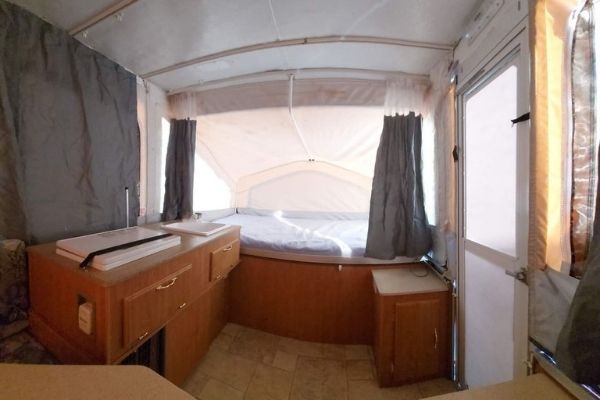
Fishing Bridge Campground in Yellowstone National Park (Wyoming) and Lake Louise Trailer Campground in Banff National Park (Alberta) do not allow soft-sided campers due to ongoing bear activity.
Many park campgrounds are also tent camping only. So although they are not specifically excluding just pop-up campers, you may find that a favorite campground is no longer an option once you move from a tent to a pop-up camper.
For commercial campgrounds, you’ll find more restrictions and ‘hard-sided only’ locations are more common. Always check the requirements of campgrounds before making a reservation or relying on a drive-up, first-come-first-served space.
Pop Up Campers Might Not Be Fully Secure
This is a double-edged sword as the use of canvas and fabric in the design of pop-up campers provides the foundation for their main advantages – size and weight.
These soft materials have many drawbacks though. I’ve mentioned the noise level and privacy issues already, but another concern is the lack of true windows- pop-up campers just have screens. This means your pop-up is no more secure than a standard tent, but likely contains more belongings that would interest thieves.
Rain Is A Problem With Pop-Up Campers.
Do pop-up campers leak? Well, it should not leak, but if there is an extended period of rain and it’s really heavy rain, it can get really muggy and the fabric can feel wet. The screens also have the same risk as screens on tents …. When to leave them open and when to close them?
In hot weather, it’s tempting to leave the screens open and try and make use of any cooling breeze. But that afternoon thunderstorm will always roll through when you are away from your pop-up camper, and you’ll return to sodden bedding and possessions.
It rained hard when we went out and it was messy and not that fun! Even if you’ve closed the screens, the canvas will remain damp until the weather improves.
Setting Up, And Packing Up, Your Pop-Up Camper Takes Time
Unfurling and erecting a pop-up camper is more time-consuming than most people appreciate. There is the same time needed for site evaluation, leveling, and stabilizing as with a travel trailer, but with the added time to unpack, lift and set up the pop-up camper.
Setting up in the rain is especially demoralizing as everything seems to end up wet before you even start. The design of your pop-up makes a difference. So, if you know you’ll be camping a lot in rainy areas, look for a pop-up camper with permanently attached bunk-ends, as this will at least stop the mattresses from getting wet.
Packing up a wet pop-up camper is no fun. If you end up taking the pop-up camper down in the rain, mud and water are brought inside when you are packing it up. Then when you get home, you have to set It up again to dry it out. So, keep spare clothes in your tow vehicle so that you can change them before the drive home. Otherwise, you’ll be soaked all the way home after packing away in the rain.
It Can Be Frightening To Be Inside A Pop Up Camper In High Winds
Like a tent, high winds can feel especially terrifying in a pop-up camper. As a general guide, winds over 40mph can prove hazardous to pop-ups. However, the exact wind speed that will impact your pop-up camper is affected by a number of factors including the size and weight of the pop-up camper, location, and (less obviously) the quality of the chocks used.
Adding guy lines and ground anchors, bringing in the awning and slide-outs, and choosing the site carefully will all help reduce the chances of wind damage.
Pop Up Campers Are A Cost-Effective, Entry-Level RV
Pop-up campers cost considerably less than a travel trailer with the same floor space. New models start at around $10,000. The smallest travel trailers start at about $16,000 new and, at that price, will have less floor space than a pop-up camper. I had a look into buying one potentially until we rented it and decided it was not really for us. So here’s an article on it.
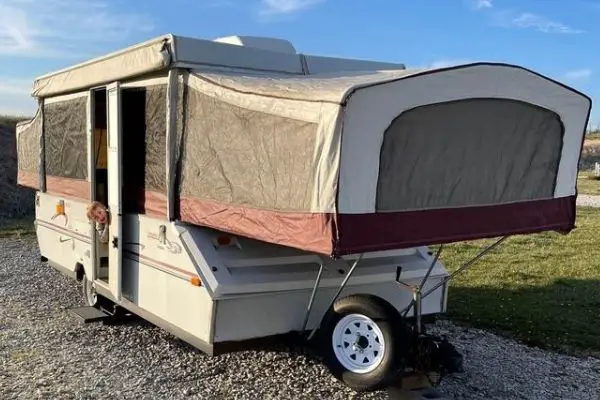
Pop Up Campers Have A Strong Used Market And Slow Depreciation
There is a strong market for used pop-up campers. Many campers who are new to pop-up campers will start with a used model due to the reduced initial costs. Pop-ups depreciate less than equivalent hard-sided models too. This is due to the strong ongoing interest in used models as others are looking to get into RVing.
The Lifespan Of A Pop-Up Camper Is Less Than Travel Trailers
Pop-up campers have a shorter lifespan than equivalent travel trailers. This stems from the added complexities of the opening and closing mechanism and the reliance on canvas and fabric.
Good care and maintenance play a role, of course, and you can certainly lengthen your pop-ups’ lifespan. Here are a few simple steps that should add longevity to your pop up camper:
- Ensure that the canvas is clean and dry before packing away the pop-up
- Repair damage such as tears in the canvas as soon as possible
- Insects and rodents can damage any camper. Take care to clean up food waste, and block any access holes.
- Lubricate your lift system per manufacturers’ recommendations
- Check tire pressure, tire wear, etc. as you would on any vehicle
You Might Be Able To Store Your Pop Up Camper At Home
A key plus point for pop-up campers over conventional travel trailers is that you may well be able to store your pop-up tent camper in your garage. This saves winter storage costs and helps keep your pop-up in the best condition possible.
Pop-up campers start at 8’ long, with common models being available up to 16’. They are generally 7 to 7’6” wide and under 5’ in height when collapsed. It varies but an average single garage is 12’ wide and 22’ long, giving you a little extra storage space even when your pop-up camper is stored.
Your Family Car Might Be Enough To Tow Your Pop-Up Camper
Perhaps the number one advantage of a pop-up camper, when compared to a travel trailer, is that the lower weight means you can probably tow the pop-up with your midsized family SUV. The additional cost of a truck (as is usually needed with trailers) can be a huge negative when you are trying non-tent camping for the first time.
Investigate the towing capacity of your existing vehicle carefully. Do not buy a pop-up camper whose weight is close to the maximum towing ability of your car. You’ll need to allow a good margin for water tanks, belongs, etc.
As an example, a standard Ford Explorer can tow up to 2000lbs. The average pop-up is 2500lbs, so you’d need to investigate the very lightweight pop-up campers in order to tow with an Explorer. In contrast, a Honda Pilot can tow up to 3500lbs. Regardless of the manufacturer, it’s important to check the specifics of your model though. Also, the actual process of towing a lighter RV, such as a pop-up camper, is usually more appealing to folks new to towing.
Understand Why You’re Buying A Pop-Up Camper
It’s important to think carefully about why you’re considering purchasing a pop-up camper. If you are looking for more privacy over your existing tent options, the pop-up might not provide this. If you want a wet weather haven where you and your belongings are securely tucked away from the elements, again a pop-up might not be the right choice.
If you’re looking for a bathroom for just you and your travel companions, you’ll need to search within the available models. But if you want an entry-level recreational vehicle that costs far less than an equivalent truck and travel trailer combination and will enable you to explore the benefits of a home on wheels, then a pop-up might be just the thing.
Add slow depreciation, ease of storage, and the potential that your existing family car will be able to tow your new pop-up camper too, and you can see the attractions!
Red Flag Issues With A Used Pop-Up Camper
There is a strong used market for pop-up campers … good news when you come to sell. However, you’ll want to evaluate any used camper purchase carefully in order to avoid expensive repairs. A few key things to look for are:
• Worn and/or damaged canvas
• A leaking or rotted roof
• A sagging, cracked, or otherwise damaged roof
• Soft spots on the floor
• A warn or damaged lift system
• Any bent or damaged framework or rods
Avoid RVs that show any of these warning signs. Try all the systems on the pop-up before buying. Don’t forget to run the water, try all the electrical outlets, the stovetop, and (if appropriate) the bathroom and tanks too.
Rent Before You Buy
Rather than jumping straight into a purchase, a very good way to investigate pop-up camping is to rent different models for a series of short trips. This can be especially helpful when you’re trying to decide between models and the various features you need. You’ll also be able to evaluate how your tow vehicle performs and handles.
A one-night rental of a pop-up camper starts at around $60, but that varies hugely with location and date. Lower price options are certainly available if you shop around. You may even decide that renting is the best route for you long term, as it saves any storage and maintenance concerns. You will also be able to access new models and take differing pop-ups depending upon the exact needs of each trip.
Think About The Key Features That You Really Need
As I’ve mentioned, although you can find pop-up campers with cassette toilets and shower units, pop-ups do not normally have bathrooms as a standard feature. You’ll find the size of any hot water tank, is a limiting factor for your showers. You’ll need to think about when you’ll need hot water in your kitchen sink, versus the shower.
Several models come with outdoor showers, which might be all you need to rinse the sand off your children or mud off the dog. And adding a bathroom will add time for waste disposal and tank emptying too.
For cooking, having an indoor stovetop might be appealing, but some models have outdoor stoves. The latter can help keep odors and grease splashes outside the pop-up but, rather obviously, you’ll be cooking outside. Many models have a small refrigerator, but it’s unlikely to be enough for a family of four for more than a couple of nights. Evaluate carefully the features you need and prioritize from there.
Other Indoor Amenities In Your Pop-Up Camper
Once you look past the most basic of features- dinette, mattresses, bench seating … there are a host of additional features to consider from the apparently basic to the luxurious.
You should not have difficulty finding a pop-up with a stovetop and sink, but what about other kitchen features such as an oven or microwave, or even a freezer? There are certain models available with additional kitchen equipment. These add-ons are usually space and electricity heavy though, which is why they are not standard features. Being able to check that you actually need these amenities is another plus about renting before you buy.
For your mattresses, and cooler weather camping, you might want to consider heated mattress pads. And for ease of use, there are campers with powered lift systems. Some pop-up campers come with water purification systems, stereo and outdoor speakers, iPhone adaptors, and cable TV hooks up. As said, if you’re looking for a little of the 21st century to sit alongside your fire pit, there is probably a pop-up camper that will fit your needs.
Outdoor Features Of Your Pop-Up Camper
An outdoor stove or shower are probably the two main features to consider on the outside of your pop-up camper. Both get the associated ‘mess’ out of the main camper compartment and depending upon your requirements and likely camping locations, might be ideal for your needs.
Many campers with a bathroom-less pop-up will add an external tent and a portable toilet for a bathroom. It has the plus point of privacy, without reducing space in the main camper. Some may add a shower tent too, for the full ‘en suite’ experience.
Storage compartments that you access from the outside are common in travel trailers but rarer in pop-up campers. So, for example, can the trunk of your car double as a store for beach toys, firewood, or other larger items? Or will you need the space for other items?
Making Your Pop-Up Camper A Home On Wheels
One of the attractions of RV travel is that your home on wheels is ready to go and you no longer need to load (and unload) camping gear into your car for every trip. However, this only really works if you can equip your pop-up camper with everything you need … and leave the items there permanently.
There will likely be items that don’t make sense to replicate such as fishing gear. But where possible try and slowly add items solely dedicated to the pop-up camper- beach towels, sweaters, thick socks, pots and pans, long electrical extension cable, toilet roll, canned food, and can opener, bedding … Then you’ll be able to set off on your trip after simply adding a cool box of fresh food and a few clothes.
Ideas To Help With Limited Storage In A Pop-Up Camper
Storage space is notoriously limited in pop-up campers. Lots of equipment now comes in a collapsible variety – including trash bins and dishware. Under-shelf baskets can double your apparent cupboard space. And it may seem counterintuitive to place items in storage containers, but you can stack these and ultimately keep an illusion of space by having surfaces clear of items.
Magnetic strips can be used to store knives, other silverware, and utensils, once you’ve set up a camp of course. And suction cup hooks have a multitude of uses. Mesh bags in various sizes add an option of hanging items, including under counters. Get creative with the storage solutions that work for you!
The Other Costs Of Owning A Pop-Up Camper
As well as the actual purchase price of your pop-up camper, there are a number of other expenses to consider. You will likely need some additional items over existing camping gear, but minimize these to start with until you can clearly see what you need. If you managed with your existing items in a tent, you can probably manage with those same items in a pop-up.
Your gas costs will increase as your family SUV will not have the same efficiency once it is also towing a pop-up camper. The overall wear on your car will increase too. You will also have the costs of fitting a tow hitch to your existing car, and potentially stabilizing bars for heavier pop-up campers. On a long trip, the extra toll road costs can add up as well.
Campground costs for RVs are generally higher than for a tent campsite. And if you want to find a site with an electrical hook up, you will have less choice and availability. If you have a bathroom, there might be dump station fees too. And you might now also need propane, depending upon your camper’s features.
Finally, if you are unable to store your pop-up camper at home, then there will be storage fees when not in use. And of course, there are always insurance, maintenance, and repair costs.
Are Pop-Up Campers Worth It?
This question is hard to answer, as it depends on the person and the family as well as their budget. For me having grown up with a motorhome when I was young it was not worth it for me. I cherish that time when we rented a pop-up trailer and gained the personal experience of a pop-up trailer.

